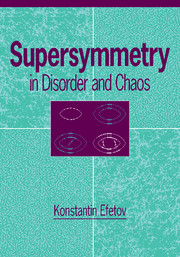Book contents
- Frontmatter
- Contents
- Preface
- Acknowledgments
- 1 Introduction
- 2 Supermathematics
- 3 Diffusion modes
- 4 Nonlinear supermatrix σ-model
- 5 Perturbation theory and renormalization group
- 6 Energy level statistics
- 7 Quantum size effects in small metal particles
- 8 Persistent currents in mesoscopic rings
- 9 Transport through mesoscopic devices
- 10 Universal parametric correlations
- 11 Localization in systems with one-dimensional geometry
- 12 Anderson metal–insulator transition
- 13 Disorder in two dimensions
- 14 Afterword
- Appendix 1 Calculation of the Jacobian
- Appendix 2 Magnetic field parametrization
- Appendix 3 Density–density correlation function at k = 0
- Appendix 4 Effective medium approximation as a saddle point
- References
- Author index
- Subject index
14 - Afterword
Published online by Cambridge University Press: 10 November 2010
- Frontmatter
- Contents
- Preface
- Acknowledgments
- 1 Introduction
- 2 Supermathematics
- 3 Diffusion modes
- 4 Nonlinear supermatrix σ-model
- 5 Perturbation theory and renormalization group
- 6 Energy level statistics
- 7 Quantum size effects in small metal particles
- 8 Persistent currents in mesoscopic rings
- 9 Transport through mesoscopic devices
- 10 Universal parametric correlations
- 11 Localization in systems with one-dimensional geometry
- 12 Anderson metal–insulator transition
- 13 Disorder in two dimensions
- 14 Afterword
- Appendix 1 Calculation of the Jacobian
- Appendix 2 Magnetic field parametrization
- Appendix 3 Density–density correlation function at k = 0
- Appendix 4 Effective medium approximation as a saddle point
- References
- Author index
- Subject index
Summary
It is clear from the material presented here that the supersymmetry technique, in particular, the supermatrix nonlinear σ-model, is an extremely efficient way of studying various problems. A natural question may be asked: Why does all this work? What is the physical meaning of the invariance of the σ-model under rotations of supermatrices Q?
These questions are not easy to answer. I cannot explain why the supermatrix σ-model enables us to get some nontrivial results that cannot be obtained by other methods currently available. The supersymmetry formalism was derived from the Schrödinger equation with a random potential. All symmetries of the σ-model appeared in the process of the derivation, but the initial Schrödinger equation does not contain them. My attitude to these questions is that all nice symmetry features of the σ-model are formal and it is difficult to attribute to them a clear physical sense.
I want to emphasize that the Grassmann anticommuting variables χi were introduced in a completely formal way. The initial Schrödinger equation did not contain them and they were introduced with the hope that they would help in the calculations. I cannot explain why the variables χi that are completely formal mathematical objects helped to get the results. However, it is not unusual for abstract mathematical objects to be useful for explicit computations.
- Type
- Chapter
- Information
- Supersymmetry in Disorder and Chaos , pp. 402 - 403Publisher: Cambridge University PressPrint publication year: 1996



